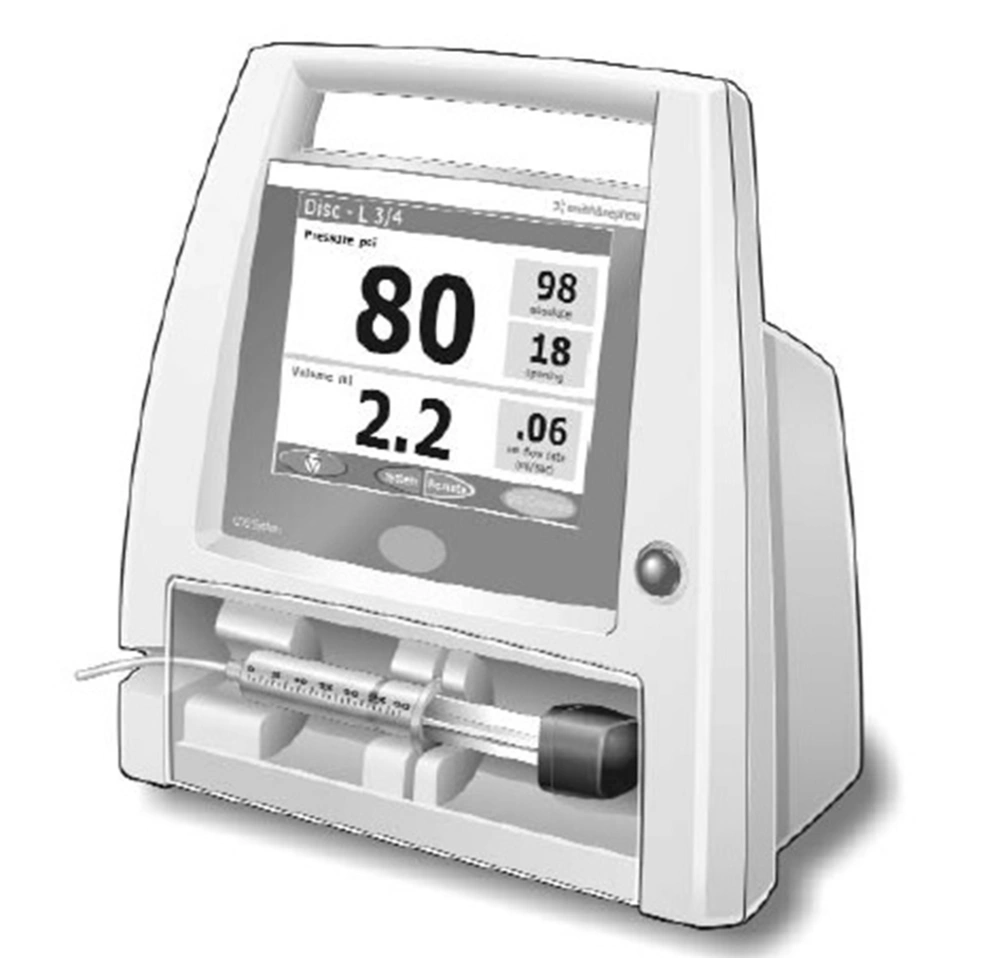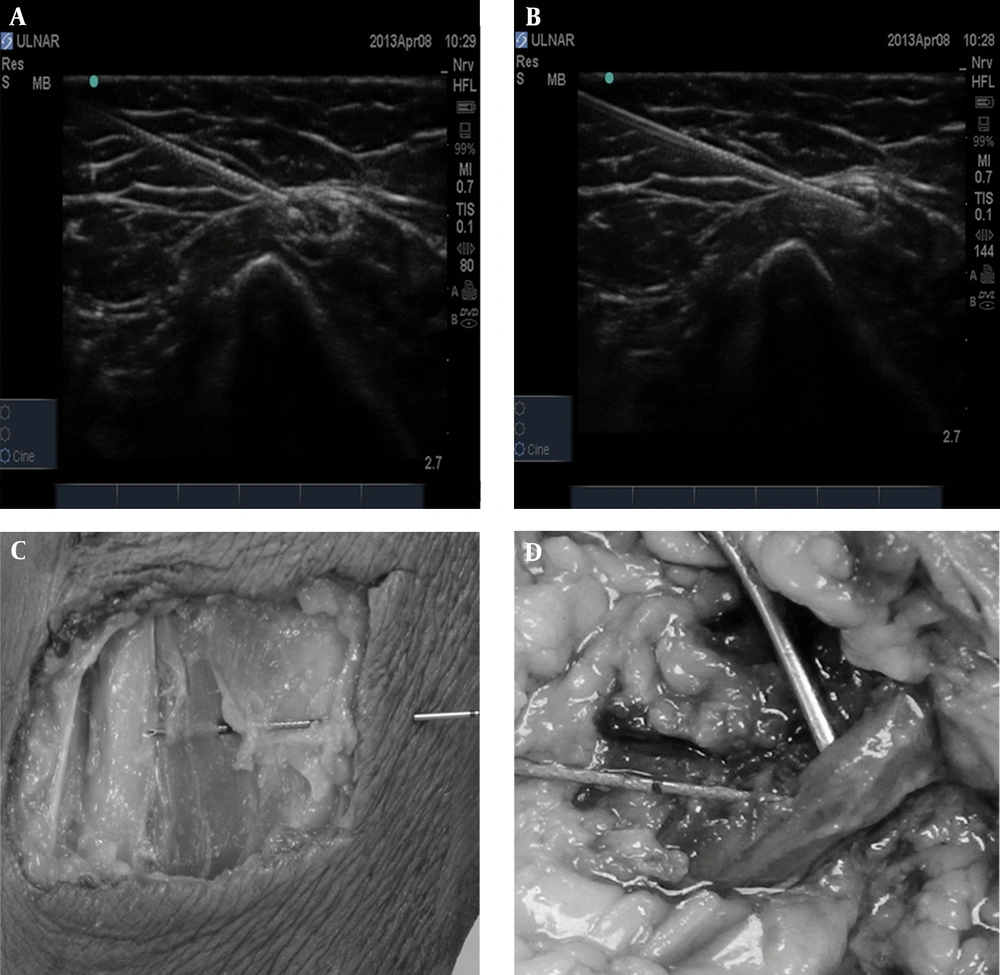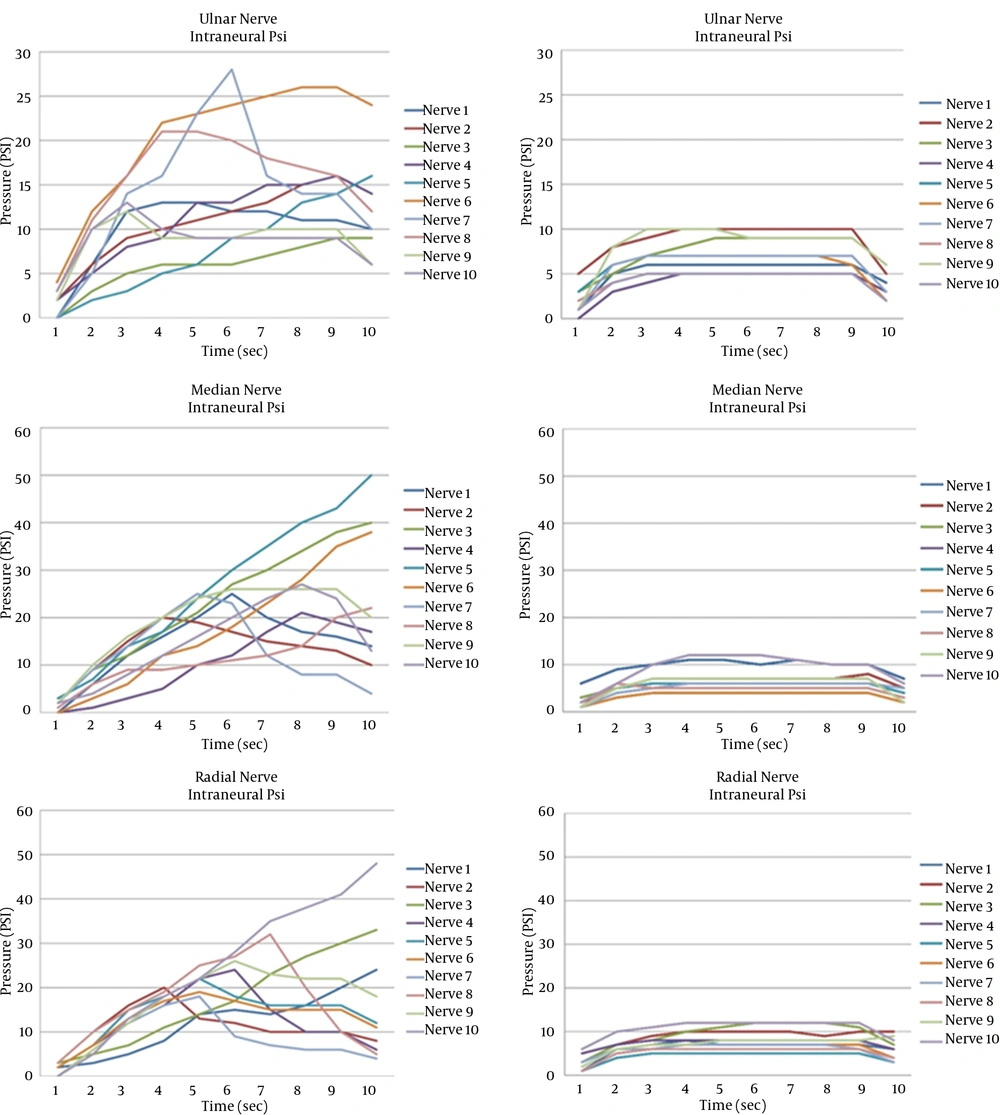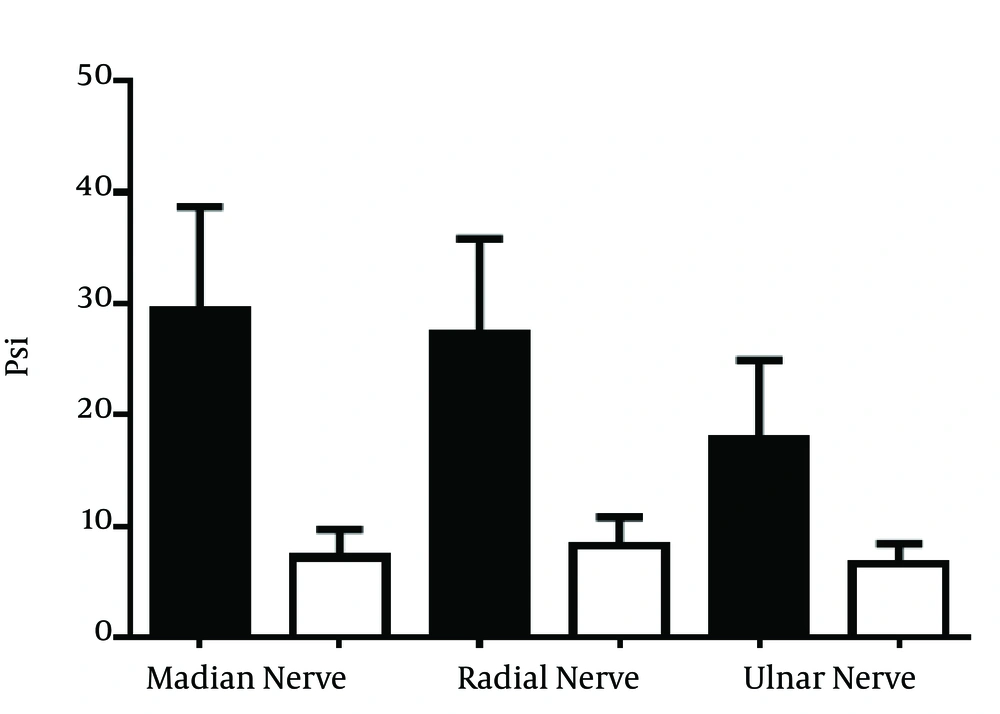1. Background
Following the introduction of the nerve stimulator 40 years ago (1) and two decades since the application of the ultrasonography (USG) into contemporary regional anesthesia (RA) practice (2), a consensus is yet to be reached on the level and methods of monitoring needed during nerve block to confirm exact needle placement. Although USG, nerve stimulator, injection pressure, and patient wakefulness have all been suggested, specific use and combination of these factors has not been accepted universally (3, 4). Reports of intraneural needle placement with no neurologic consequences have created much confusion and resulted in a plethora of papers regarding safety of intraneural needle placement during RA, which is comprehensively reviewed by Sala-Blanch et al. (5). Overall incidence of nerve injury associated with RA has been estimated between 1:5000 and 1: 2500 (6-8). Its association with the final needle position is even less clear and since the incidence of injury is very low, these quoted studies with small numbers are not sufficient to guide us. Therefore, intraneural (beyond the epineurium) needle placement cannot be recommended (9, 10) due to the potential risk of permanent nerve damage leading to disability as well as triggering litigation (11). As a result of clinical wisdom, a combination of USG, nerve stimulation, and injection pressure monitoring in awake patients was suggested for the early detection of intraneural needle placement and prevention of subsequent intraneural injection (3, 12). Using animal models to investigate the association between injection pressure and intraneural needle placement has produced conflicting results. Selander and Sjostrand (13) were the first to illustrate that intraneural injections would produce a sustained and elevated pressure increases. Furthermore Hadzic et al. (14) discovered that all intraneural injections were associated with high injection pressures of 25 to 45 pound per square inch (psi; each psi is almost equal to 51.7 mmHg) and produced persistent motor deficits in all cases with > 25 psi. In addition, all perineural injections produced a much lower injection pressure of ≤ 4 psi. In contrast, studies by Altermatt et al. (15) and Lupu et al. (16) did not demonstrate a correlation between higher injection pressures and intraneural needle placement. These studies also failed to link intraneural injection to functional nerve injury or histologic evidence of intrafascicular injection. There is currently very limited human or cadaveric data regarding intraneural injection pressure (4). We are aware of a single study (17) on human cadavers where the brachial plexus roots in unembalmed human cadavers were injected and the pressure injection as well as the spread of the injected materials were recorded. The intraneural injection pressure was very high, with a mean of 48.9 psi, in comparison two control injections with needle inserted adjacent to the epineurium of C6 and C7 nerve root with pressure of 17.6 and 8.2 psi for 5 and 15 mL injected volume, respectively; however, this finding was not a primary focus of the investigation. Most recently, Gadsden et al. (18) demonstrated a higher opening injection pressure when the needle was in contact with nerve root but not beyond the epineurium in contrast with the consistently lower opening injection pressure when needle was 1 mm away from the brachial plexus roots during brachial plexus block.
2. Objectives
In light of these facts, we performed an independent investigation of USG-guided intraneural and perineural injections into the medial, radial, and ulnar nerves with the intention of recording and comparing intraneural and perineural values. We hypothesize that the intraneural injection pressure will be greater than the perineural injection pressure.
3. Materials and Methods
All of the cadaveric tissues were obtained and utilized in accordance with the Human Tissue Act (2004), which includes first person consent for cadaveric investigation. Cadaveric preservation involved the use of phenol and glycerol rather than formaldehyde, which allowed similar tissue mobility as in vivo conditions. A total of 60 injections were conducted using 12 cadaveric arms from six cadavers. Five cadavers were initially provided to perform bilateral radial, median, and ulnar nerve injections (30 intraneural and 30 perineural). In one cadaver, the radial nerve could not be identified on one side and in another one, an ulnar nerve injection measurement was missed due to investigator’s error. As such, an extra cadaver was used to complete the sixty injections. In total, 20 injections were conducted for each of the radial, median, and ulnar nerves (10 intraneural and 10 perineural). All injections were performed at the level of the distal arm. Radial nerve was localized at the anterior compartment of the arm after leaving spiral groove between brachialis and brachioradialis muscle and before division into deep and superficial branch. Median nerve was identified medial to brachial artery in the antecubital fossa. Ulnar nerve lies most superficially under the skin, in compare to radial and median nerve, cranially to the medial epicondyle. An M-Turbo USG system (Sonosite-Fuji Inc, Bothell, WA, USA) was used with a linear 6 to 13 MHz transducer L-38 for needle placement. After identifying a cross-sectional view of the nerves at the described level, an 80-mm, 22-G needle (Sonoplex, Pajunk, Melsungen, Germany) was inserted using an in plane technique. The perineural injection was performed within 1 mm to the epineurium as per standard peripheral nerve block to ensure free flow of solution. For intraneural injection, the needle was inserted into the clearly identifiable nerve structure as seen on USG and according to the current understanding of the concept (3). For intraneural needle placement, once the needle passed the epineurium, USG assessment could not differentiate between extrafascicular (interfascicular epineurium, perineurium) or intrafascicular needle placement (endoneurium, axons). USG images of both perineural and extraneural needle position were captured and stored. Solution spread for perineural injection and nerve swelling (change in cross-sectional area) for intraneural injection were not recorded as a video clips due to a small volume of injection (1 mL) and with the assumption that it would not add value to the investigation. After needle placement, 1 mL of 0.9% NaCl was injected over ten seconds (0.1 mL/sec) and the opening injection pressure was recorded in psi using a Controlled Disc Stimulation (CDS) device (Controlled Disc Stimulation, NeuroTherm, Middleton, MA, USA) (Figure 1).
We defined opening injection pressure as the pressure peak that followed the initiation of the injection. Most of the injections produced a similar pattern of a low initial pressure, increasing to a maximal “peak pressure” (opening injection pressure) and ended in a lower pressure. Some injections did not reach peak value within ten-second injection time. The CDS device was utilized as it is known to deliver precise pressure recordings in provocative discography: volume accuracy of 0.05 mL, pressure accuracy of ± 5%, and flow rate accuracy of 1.1% as per Operation/Service Manual (19). The NeuroTherm CDS system employs a syringe pump that delivers media in a controlled fashion, a syringe with an integrated pressure transducer, and a piece of software that allows the calculation of the pressure at the tip of the needle by accounting for the fluid dynamic variables between the transducer and the tip of the needle. The calculated pressure is displayed on the CDS screen. Data was recorded using a computer-based data acquisition system (LabView, USA). In this study, encountered fluid dynamics were described using the Navier-Stokes equation, which took the key variables affecting fluid behavior into account. The key variables were fluid viscosity (cP), flow rate (mL/s), needle length (cm), needle gauge (ga), tubing length, and tubing diameter. To detect any difference in terms of needle length, we measured the baseline (needle open to air) pressure of injection of 1 mL of 0.9% NaCl at a rate of 1 mL in ten seconds with 22-G needles of consecutively 100-mm, 80-mm, and 50-mm lengths as these needle lengths are routinely used clinically. The tubing length was kept the same in each case. The present investigation chose the 80-mm needle as it was most commonly used in clinical practice in our institution. Peripheral nerve block of median, ulnar, and radial nerve, selectively or in combination, often follows immediately infraclavicular brachial plexus block to speed up onset in desired distribution. Needles were left in situ after completing the injection and recording of injection pressure. The cadavers were subsequently dissected to confirm needle placement. The dissections confirmed needle placement and are illustrated together with the USG images in Figure 2. All injections were performed by main investigator (AK) with more than eight years of experience in USG-guided interventions. Injection pressures were recorded on CDS device by DD (David Drew - Operator of CDS device (AK) being blinded to the needle position. All dissections were performed by MS and AV. The data was statistically analyzed using paired-samples t tests to compare the intraneural and perineural values obtained from the same nerves. Significance was assumed at P < 0.05. All statistical analyses were conducted using GraphPad (version 6, USA).
4. Results
The baseline pressure of injection of 1 mL of 0.9% NaCl at a rate of 0.1 mL/sec with 100-mm, 80-mm, and 50-mm 22-G needles showed no difference in pressure values (Table 1). All of the cadaveric dissections confirmed that the needle was positioned correctly (Figure 2). The CDS graphs produced following the injection of 1 mL of 0.9% NaCl in ten seconds are displayed in Figure 3. This data shows that intraneural placed needles produced a greater injection pressures in comparison to perineural injections across all three nerves. The means of generated pressures by intraneural and perineural injections into the median nerve were respectively 29.4 ± 9.3 and 7.2 ± 2.5 (P < 0.01). The means of generated pressures in the radial nerve through intraneural and perineural injections were respectively 27.3 ± 8.5 and 8.3 ± 2.5 psi (P < 0.01). The means of generated pressures in the ulnar nerve by intraneural and perineural injections were 17.9 ± 7.0 and 6.7 ± 1.8 psi (P < 0.01) (Figure 4). All perineural injections produced a pressure of < 12 psi. In contrast, all intraneural injections pressures for median nerve and all of that for radial nerves, except one measurement, were > 20 psi. These results are illustrated in Table 2 and Figure 4.
| Side | Opening Injection Pressure | |||||
|---|---|---|---|---|---|---|
| Median Nerve | Radial Nerve | Ulnar Nerve | ||||
| Intraneural | Extraneural | Intraneural | Extraneural | Intraneural | Extraneural | |
| 1 | ||||||
| Right | 25 | 10 | 23 | 8 | 13 | 6 |
| Left | 20 | 7 | 20 | 9 | 16 | 10 |
| 2 | ||||||
| Right | 40 | 6 | 33 | 12 | 9 | 5 |
| Left | 22 | 5 | 24 | 8 | ||
| 3 | ||||||
| Right | 48 | 6 | 21 | 4 | 15 | 6 |
| Left | 38 | 10 | 26 | 7 | ||
| 4 | ||||||
| Right | 26 | 5 | 18 | 6 | 27 | 6 |
| Left | 22 | 5 | 32 | 6 | 21 | 5 |
| 5 | ||||||
| Right | 26 | 6 | 26 | 9 | 12 | 9 |
| Left | 27 | 12 | 47 | 12 | 12 | 5 |
| 6 | ||||||
| Left | 29 | 9 | 28 | 8 | ||
| Mean ± SD | 29.4 ± 9.299 | 7.2 ± 2.529 | 27.3 ± 8.538 | 8.3 ± 2.54 | 17.9 ± 7.03 | 6.7 ± 1.7669 |
5. Discussion
The obtained results demonstrate a statistically significant difference between intraneural and perineural injection pressures in the median, ulnar, and radial nerves in soft-preserved cadaveric tissues. Additionally, considerable variation between the intraneural injection pressures of the ulnar nerve was discovered in comparison to the radial and median nerves. For six out of ten ulnar nerves intraneural injections, the injection pressure was < 20 psi. The present investigation confirms previously identified positive correlations between increased injection pressures and intraneural placement (13, 18, 20). Orebaugh et al. (17) conducted a study in which unembalmed cadaveric nerve roots were injected intraneurally at the C6 and C7 level and the pressure of injection as well as the spread of the injected materials was recorded. Their results’ were in concordance with our findings and showed that intraneural needle placement produces an elevated injection pressure with a mean time to peak injection pressure of 10.3 ± 3.3 seconds. Their values, however, were significantly greater than ours were (mean of 48.9 vs 24.9 psi). The most likely explanation of the difference between our studies results involves the histologic variation between the peripheral nerves and the cervical roots with respect to fascicle number and size and the amount of connective tissue within the nerve. USG commonly shows a different appearance between hypoechoic (black appearance) proximally to hyperechoic (honeycomb appearance) distally in peripheral nerves (9). The histologic variation in peripheral nervous structure has recently been demonstrated by Reina et al. (21) and offered as an explanation for the sporadic severity and range of nervous damage following intraneural injections in RA. Although histologic microscopic examinations determining the exact needle position within the nerve (whether intrafascicular or extrafascicular) were not conducted, the contraindication of advancing a needle beyond epineurium (9, 10) made this unnecessary. The pressure monitoring device used in their studies was PV350 (Fluke Corporation, Everett, Washington), which is a pressure/vacuum transducer and differs to the CDS device used in our study, which is used to measure injection pressures during intradiscal injections. A probable explanation for the difference in magnitude of the opening injection pressures is that the greater values were achieved in their study though the use of a greater injection rate and volume of fluid. Orebaugh et al. (17) used 5 mL of fluid with a rate of 5 mL per 15 seconds (0.33 mL/sec) in comparison to 1 mL of NaCl with a rate of 0.1 mL/sec in our study. Introducing larger volume with faster rate into an enclosed space, such as the cervical nerve roots, might explain the greater increase in pressure. The embalming of cadavers with phenol and glycerol in comparison to unembalmed cadaveric tissues might also be an important factor. The data also showed considerable variation between the ulnar nerve intraneural injection pressures in comparison to the radial and median nerves. This might suggests some histologic differences between the epineurium, intrafascicular, and extrafascicular anatomy between these nerves. The authors acknowledge this to be an area that warrants further investigation. We have chosen median, radial and ulnar nerve for our initial studies for various reasons; first, it is common in our institution to supplement supraclavicular/infraclavicular/axillary block with abovementioned nerves depending on required field of surgery to reinforce and speed up block onset. Second, at the investigated level, nerves are in isolation, clearly identified on USG, and can be blocked selectively. Third, all three nerves were easy to dissect at the described position. We admit that nerve structures at location such as cervical roots, trunks, divisions, cord, and nerves of lumbar and sacral plexus such as femoral and sciatic are subject of our next investigation to produce “map of injection pressure“. One of the main limitations of our study was that the results were obtained from soft embalmed cadavers, which might not reflect the rigor of the human tissues. Additionally, the current study injected 1 mL of 0.9% NaCl at a rate of 0.1 mL/sec for 10 seconds. The 1-mL volume was chosen as it is common in clinical practice to inject 1-mL aliquots to assess the visible spread and rely on assistant/device feedback measuring resistance to injection. Chan et al. (22) confirmed that USG is able to detect 1 mL of injected material. We are aware, however, that this injection rate was much slower than usual clinical practice and the injected volume was much lower. It has been chosen deliberately hypothesizing that if we were able to prove statistically significant difference between intraneural and perineural pressure injection of such a small volume and rate, it would be even more significant for higher rates and volumes. We consider it rather as a strength and not weakness of our study. In their study design, Hadzic et al. (14) injected 4 mL of 2% lidocaine at the rate 1 mL per 15 seconds (0.66 mL/sec). In another study, the rate of injection created by anesthetists during simulated nerve block was recorded as between 2 to 6 mL/sec (23). The most recent conducted animal studies have contradicted the association between increased injection pressures and intraneural needle placement. Lupu et al. (16) used the open model of the porcine median nerve and direct needle placement to inject up to 20 mL of 2% lignocaine with 5 μg/mL (1: 200.000) adrenaline or until an extraneural leakage was seen on USG. The injection of local anesthetic induced histologic evidence of inflammation in seven out of ten swine; however, none of the specimens exhibited functional neurologic deficits. The mean value obtained for the intraneural injections was 5.1 ± 2.9 psi. Altermatt et al. (15) conducted a similar study in which, 4 mL of India ink was injected. The mean intraneural injection pressure was 7.4 psi with a wide range (0.07 - 31.5 psi). The injection pressure was recorded every two seconds in this study. Unfortunately the rate of fluid injection was not described in the methodology. However, one must consider the differences in methodology between these papers. In both of Lupu et al. and Altermatt et al. (15, 16) works, the injection pressure measurements were the secondary focus. Different injected materials as well as different needle length and gauge size were used in all the studies. All of these factors contribute to fluid dynamics in the Navier-Stokes equation. This makes comparing and extrapolating our findings difficult. An in-depth discussion about the limitations of the above articles is beyond the scope of this paper. In detailed review regarding needle to nerve proximity and its consequences in animal studies, Macfarlane et al. (24) concluded that high injection pressure is neither sensitive nor specific to detect intraneural injection but low injection pressure might be useful for its negative predictive value. At the time of conducting the study, there was no commercial device in Europe to monitor injection pressure during regional blocks. If pressure monitoring is to be widespread and we are going to move from dual to triple monitoring, the device should be easy to use, portable, reliable, and affordable.
In conclusion, we have demonstrated that intraneural injections produce greater injection pressure in comparison to perineural injections, supporting our hypothesis. We used a small volume (1 mL) of saline solution (0.9% NaCl) for a longer (10 seconds) than traditional injection time, which was capable of demonstrating statistically significant differences between intraneural and perineural injections. Our study showed that pressure monitoring has a high sensitivity as all extraneural injection pressure were < 12 psi, which was in concordance with the results by Selander and Sjostrand (13) and Hadzic et al. (14). We also conclude that pressure monitoring has a low specificity, as false positive readings might occur once the needle tip is obstructed by sitting directly against a bone, ligament, tendon, or the nerve (18). We acknowledge that more studies are needed to investigate the complicated association between needle placement and injection pressure as histologic differences might exist among various peripheral nerves warranting “pressure mapping” to elucidate potential clinical implications. Injection pressure recording, which also includes volume, rate of injection, type of solution, needle size, length, tip shape, and model type (open-close), should be part of a robust protocol.



